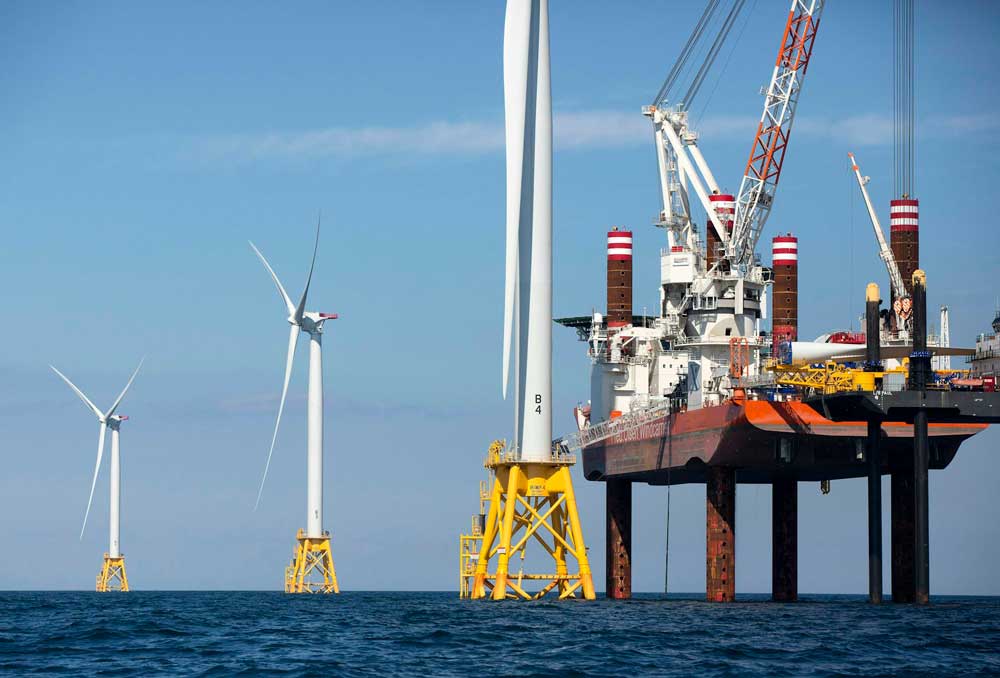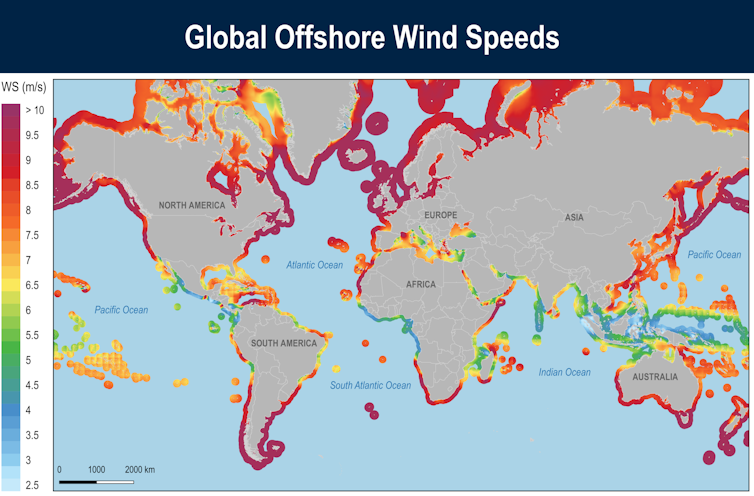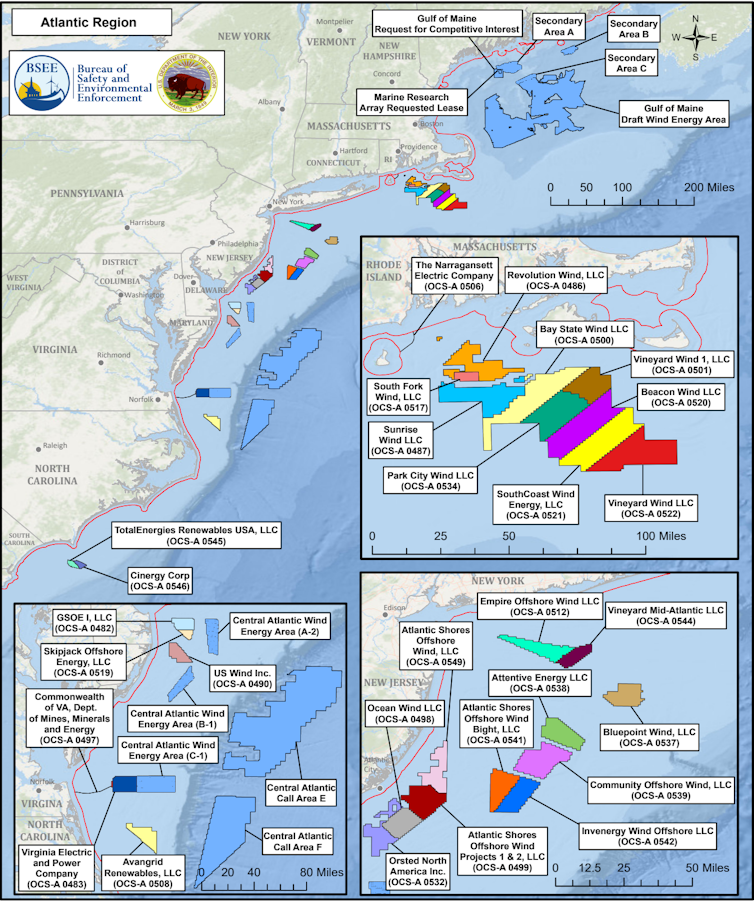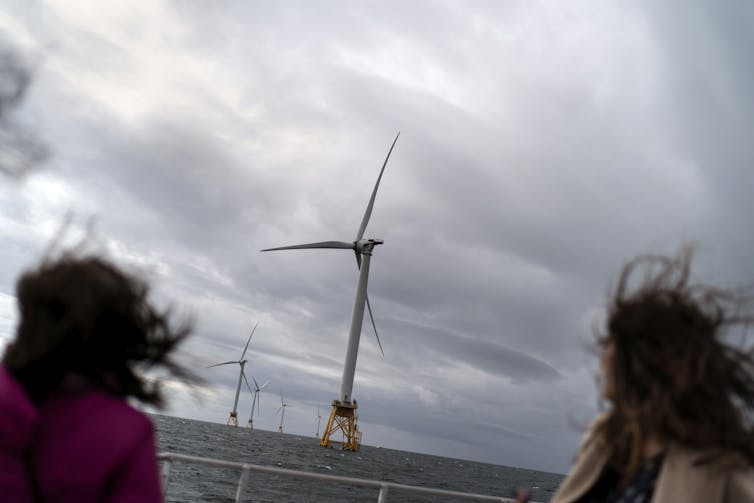
By Christopher Niezrecki
America’s first large-scale offshore wind farms began sending power
to the Northeast in early 2024, but a wave of wind farm project cancellations and rising costs have left many people with doubts about the industry’s future in the U.S.
Several big hitters, including Ørsted, Equinor, BP and Avangrid, have canceled contracts or sought to renegotiate them in recent months. Pulling out meant the companies faced cancellation penalties ranging from US$16 million to several hundred million dollars per project. It also resulted in Siemens Energy, the world’s largest maker of offshore wind turbines, anticipating financial losses in 2024 of around $2.2 billion.
Altogether, projects that had been canceled by the end of 2023 were expected to total more than 12 gigawatts of power, representing more than half of the capacity in the project pipeline.
So, what happened, and can the U.S. offshore wind industry recover?

ESMAP/The World Bank via Wikimedia, CC BY
I lead UMass Lowell’s Center for Wind Energy Science Technology and Research WindSTAR and Center for Energy Innovation and follow the industry closely. The offshore wind industry’s troubles are complicated, but it’s far from dead in the U.S., and some policy changes may help it find firmer footing.
Long approval process’s cascade of challenges
Getting offshore wind projects permitted and approved in the U.S. takes years and is fraught with uncertainty for developers, more so than in Europe or Asia.
Before a company bids on a U.S. project, the developer must plan the procurement of the entire wind farm, including making reservations to purchase components such as turbines and cables, construction equipment and ships. The bid must also be cost-competitive, so companies have a tendency to bid low and not anticipate unexpected costs, which adds to financial uncertainty and risk.
The winning U.S. bidder then purchases an expensive ocean lease, costing in the hundreds of millions of dollars. But it has no right to build a wind project yet.

U.S. Department of the Interior, 2024
Before starting to build, the developer must conduct site assessments to determine what kind of foundations are possible and identify the scale of the project. The developer must consummate an agreement to sell the power it produces, identify a point of interconnection to the power grid, and then prepare a construction and operation plan, which is subject to further environmental review. All of that takes about five years, and it’s only the beginning.
For a project to move forward, developers may need to secure dozens of permits from local, tribal, state, regional and federal agencies. The federal Bureau of Ocean Energy Management, which has jurisdiction over leasing and management of the seabed, must consult with agencies that have regulatory responsibilities over different aspects in the ocean, such as the armed forces, Environmental Protection Agency and National Marine Fisheries Service, as well as groups including commercial and recreational fishing, Indigenous groups, shipping, harbor managers and property owners.
For Vineyard Wind I – which began sending power from five of its 62 planned wind turbines off Martha’s Vineyard in early 2024 – the time from BOEM’s lease auction to getting its first electricity to the grid was about nine years.
Costs can balloon during the regulatory delays
Until recently, these contracts didn’t include any mechanisms to adjust for rising supply costs during the long approval time, adding to the risk for developers.
From the time today’s projects were bid to the time they were approved for construction, the world dealt with the COVID-19 pandemic, inflation, global supply chain problems, increased financing costs and the war in Ukraine. Steep increases in commodity prices, including for steel and copper, as well as in construction and operating costs, made many contracts signed years earlier no longer financially viable.
New and re-bid contracts are now allowing for price adjustments after the environmental approvals have been given, which is making projects more attractive to developers in the U.S. Many of the companies that canceled projects are now rebidding.
The regulatory process is becoming more streamlined, but it still takes about six years, while other countries are building projects at a faster pace and larger scale.
Shipping rules, power connections
Another significant hurdle for offshore wind development in the U.S. involves a century-old law known as the Jones Act.
The Jones Act requires vessels carrying cargo between U.S. points to be U.S.-built, U.S.-operated and U.S.-owned. It was written to boost the shipping industry after World War I. However, there are only three offshore wind turbine installation vessels in the world that are large enough for the turbines proposed for U.S. projects, and none are compliant with the Jones Act.
That means wind turbine components must be transported by smaller barges from U.S. ports and then installed by a foreign installation vessel waiting offshore, which raises the cost and likelihood of delays.

AP Photo/Seth Wenig
Dominion Energy is building a new ship, the Charybdis, that will comply with the Jones Act. But a typical offshore wind farm needs over 25 different types of vessels – for crew transfers, surveying, environmental monitoring, cable-laying, heavy lifting and many other roles.
The nation also lacks a well-trained workforce for manufacturing, construction and operation of offshore wind farms.
For power to flow from offshore wind farms, the electricity grid also requires significant upgrades. The Department of Energy is working on regional transmission plans, but permitting will undoubtedly be slow.
Lawsuits, disinformation add to the challenges
Numerous lawsuits from advocacy groups that oppose offshore wind projects have further slowed development.
Wealthy homeowners have tried to stop wind farms that might appear in their ocean view. Astroturfing groups that claim to be advocates of the environment, but are actually supported by fossil fuel industry interests, have launched disinformation campaigns.
In 2023, many Republican politicians and conservative groups immediately cast blame for whale deaths off the coast of New York and New Jersey on the offshore wind developers, but the evidence points instead to increased ship traffic collisions and entanglements with fishing gear.
Such disinformation can reduce public support and slow projects’ progress.
Efforts to keep the offshore wind industry going
The Biden administration set a goal to install 30 gigawatts of offshore wind capacity by 2030, but recent estimates indicate that the actual number will be closer to half that.

AP Photo/David Goldman
Despite the challenges, developers have reason to move ahead.
The Inflation Reduction Act provides incentives, including federal tax credits for the development of clean energy projects and for developers that build port facilities in locations that previously relied on fossil fuel industries. Most coastal state governments are also facilitating projects by allowing for a price readjustment after environmental approvals have been given. They view offshore wind as an opportunity for economic growth.
These financial benefits can make building an offshore wind industry more attractive to companies that need market stability and a pipeline of projects to help lower costs – projects that can create jobs and boost economic growth and a cleaner environment.
![]()
Christopher Niezrecki is Director of the Center for Energy Innovation at the University of Massachusetts, Lowell




























JW says
Another example of how America has become a follower from once a leader of the world (except of course our military industrial complex which does not produce anything of value for the people). We are also way behind with solar energy. Yet we continue to blame other countries. Let’s focus on our country and get things done. Let Congress wake up and start with educating our citizens and its politicians, yes you too!
Joe D says
Yikes! Average of 9 years to jump through all the regulations, governmental and environmental hoops? Then there’s the political aspect of “not along MY coast.” Even though they are placed so far away from the coast, you CANNOT SEE them from the shore.
Who has the knowledge to predict what supplies and labor are going to COST….9 years in the future?!? Just look at the cost of buying a house or a car back in 2015…compared to 2024!?!
We’ve GOT to streamline this process, or we are going to be paying for our utilities in both insane increases and WORSENING climate change ( from continued fossil fuel use) in the next 20 years.
I for one am exhausted by the number of Tornado Watches/Tornado Warnings/ Severe Thunderstorms warnings in just the past week from ALERTFlagler (certainly glad it exists though).
I’m CURRENTLY concerned at not being able to reach my youngest son in Houston, Texas since the second batch of storms and tornadoes ripped through Tuesday of last week…which landed here in Florida later. Finally got a text message from an unfamiliar phone number that he JUST got power back on Sunday night ( yesterday) , his house was damaged (? how much?) by a tornado….he was “slightly” (?!?!) injured, but was “healing”…and he was using someone else’s phone because his mobile carrier’s cell towers have been out of commission since the final storm on Tuesday…he’ll get back to me LATER!
The first batch of storms 10 days ago took out his power for 3 days ( so much for his fridge and freezer contents)! And “HURRICANE season” doesn’t START until June 1….
GLOBAL WARMING….we don’t HAVE no “stinkin’” GLOBAL WARMING….to paraphrase the CHEECH and CHONG comedy of 40 (?) years ago…
Endless Dark Money says
lol the elected leaders of Florida are paid well not to “believe” in climate change. Think about the profits for energy companies because thats all that matters not if you experience blackouts or loose your 500$ worth of groceries.
Dennis C Rathsam says
WINDMILLS KILL WHALES!
Mark says
Obviously Dennis did not read the above article, again. Please share the information you have to make that statement Dennis.
“In 2023, many Republican politicians and conservative groups immediately cast blame for whale deaths off the coast of New York and New Jersey on the offshore wind developers, but the evidence points instead to increased ship traffic collisions and entanglements with fishing gear.”
Dennis C Rathsam says
The evidence is flaud, my cousin, was the 1st person to see a dead whale in NJ. There were no signs of trama, or cuts. No fishing lines were present. Believe what you want, no dead whales poped up in Jersey, before the windmills were installed. I grew up at the Jersey shore….50 years I spent there, I saw dead sharks & other fish, but never a whale.
Ray W. says
Your 50-year scope of beach visions does not prove that no whales stranded on New Jersey beaches until windmills were built off the coast of Rhode Island and Massachusetts. If you can see two miles each way, that means only four miles of Jersey beaches were within your view on a clear day. Your periodic views up and down the beach do prove that you, and you alone, did not see dead whales as you looked up and down the shore.
As a child, I saw a small dead whale washed up on the shore. It was trailered off by some government vehicle later that day. That doesn’t prove that only one dead whale washed up on the shore within my scope of vision or that others did not wash up somewhere else on Volusia’s some 27 miles of beachfront. It only proves that I saw one before it was hauled off.
Since it is necessary to fact-check anything you say, due to your many factually unreliable comments, I went to the site for the Marine Mammal Stranding Center and found a listing for New Jersey whale strandings from 2002 to 2022.
An average of 6.3 whales have stranded on New Jersey beaches since 2002. Nine in 2003. Nine in 2005. No windmills then. The highest was 12 in 2019 and 2020. Five whales stranded on Jersey shores in 2021.
I used another link on the site to find the total number of whale strandings on Jersey beaches from 1978, when the organization began tracking the data, through May 2024. This link does not break down strandings by year, but it revealed a total of 257 whale strandings, or 5.6 per year.
Something tells me your anecdotal evidence is flawed, maybe even deeply flawed. I’m betting that whales have been stranding on Jersey beaches for millions of years. I don’t know how much further back reliable New Jersey whale stranding statistics go, but 45 years seems to me to be a statistically valid time frame from which to draw reliable conclusions.
I say that for the last 45 years, Dennis C. Rathsam has been thinking backwards, but that’s just me. He’s been thinking that if he didn’t see it, it didn’t happen. I say that Dennis C. Rathsam’s cousin was not the first person to see a stranded whale on a New Jersey beach. Something tells me that when the Dutch founded New Amsterdam on Long Island some 400 years ago, Dutch fisherman followed schools of migratory fish to New Jersey’s shoreline, and they saw stranded whales on New Jersey beaches.
FlaglerLive readers, chose for yourselves:
Is Dennis C. Rathsam’s anecdotal evidence based on 50-years of intermittent beach scanning within a four-mile shoreline on a clear day competent and reliable on the issue of whether whales strand on New Jersey beaches?
Is 45 years of data compiled by an organization dedicated to publishing whale stranding records reliable?
Does anyone doubt my sincerity when I say that James Madison, one of the greatest of our founding fathers, had Dennis C. Rathsam in mind, and many others like Mr. Rathsam, when he wrote of the dangers that were presented to his hoped-for liberal democratic Constitutional republic by “pestilential” partisan members of faction?
Bob J says
You might want to fact check your statement.
Endless Dark Money says
humans and pollution kill thousands of times more whales. Big oil paid for racist ron to ban wind farms may cause them to loose some profits. Sorry kids no future for you , enjoy the fascism.
Ray W. says
Interesting comment, JimboXYZ.
As I sometimes do when you claim something, anything, I factchecked your belief.
On March 31, 2023, FactCheck.org posted its assessment of your claim.
Here are the underlying facts:
An “unusual mortality event” of Humpback whale strandings on the Atlantic Coast from Maine to Florida started in 2016, when a statistical deviation upwards from the norm was documented by NOAA, the agency that tracks whale events. 190 stranded whales were found between 2016 and early 2023, an average of approximately 21 per year (since 2023 was not a complete year, approximations must be used). In the four years before 2016, the number was 12.75 per year.
On January 12, 2023, Fox News’ Jesse Waters posted on Facebook: “Wind Surveying is KILLING our Whales.” (I now know where JimboXYZ got the ALL-CAPS idea for his comment.) Mr. Waters ran a segment on the issue that day on his show.
The next day, Tucker Carlson ran a segment called: “The Biden Whale Extinction.” Wind farms were to be blamed, he said, adding: “This is the DDT of our times.”
In March 2023, Laura Ingraham posted on social media that “[t]hese whales that are washing up on our beaches is a direct result of the pre-construction that’s taking place her off of New Jersey.” She also posted that: “[H]ow ironic that what they’re doing is almost certainly killing large swaths of the whale population.
The irony, in actuality, was that during the eight-plus years of the “unusual mortality event”, the average number of whale strandings for the two full years of the Biden administration was 14.5. During the four years of the Trump administration, it was 30 strandings per year, so I find it odd that Carlson would call it a “Biden extinction.”
And, NOAA has documented two more “unusual mortality events”, one for the Mink whale and the other for the right whale. Both began in 2017, the year Trump took office. Two right whales had died early in 2023. Both bore signs of net entanglement. Necropsies on Humpback whales dating from 2016 reveal that 40% are from net entanglements. 60% were deemed inconclusive, because of too much decomposition before necropsy.
Citing experts and officials with NOAA, the fact-check article argued that warming oceans and changing fish migratory patterns reveal that whales are likely moving closer to shore than in the past, into the shipping zones off the Atlantic Coast. Whales are more susceptible to net entanglements and vessel strikes when they are closer to shore.
A NOAA Fisheries representative stated in a January 18, 2023, briefing that the mid-Atlantic Humpback whale population had grown, perhaps enough in total population to explain reports by regional partners that the whales might be following fish that were closer to shore this past winter. More whales and more vessel traffic increases the risk of vessel strikes.
As an aside, how can Tucker Carlson claim that an extinction event is occurring when Humpback whale populations are growing?
Since the argument posed by the various Fox News commentators was based on damage to whales caused by underwater sonic surveys, which are used to determine the best places to build windmill platforms, then what types of sonic surveying equipment was being used? The only places that have wind platforms that are already built or are currently under construction are off the coasts of Massachusetts, Rhode Island and Virginia Beach. Many of the whale strandings have occurred on New Jersey shores. It is unlikely that whales are being impacted by already existing or already under construction platforms. Seismic imaging equipment is most likely the source of whale injury, if any injury is actually occurring. If New York is one of the larger ports in America, is it possible that increased vessel strikes may be associated with shipping lanes, as opposed to acoustic surveys?
Wind farm site exploration uses “high resolution geophysical (HRG) equipment. HRG equipment uses very high frequency soundwaves of relatively low intensity. Unlike high intensity sonic equipment used by oil and gas exploration companies, which has to penetrate thousands of feet of sea floor to locate oil or gas pockets, sea floor topography exploration uses much less powerful sonic impulses to map the seafloor; there is no need to penetrate miles of rock and soil to find a good base for a wind platform. And the very high frequency sonic waves created to map seafloors cannot be heard by whales.
As an aside, very high frequency sonic waves are used to find the best seafloor maps for placing electrical cables, such as the type that will be installed in Flagler County if the project comes to fruition.
Finally, if anyone wishes to use acoustic systems to map the seafloor, they must obtain permits to do so. One requirement is that a company must use a fish finder to determine if any whales are within 1,640 feet of the vessel. 328 feet is the standard for other marine life. Because very high frequency sound waves dissipate over short distances in water, the distances are set in order to minimize harm to marine life during seismic imaging activity.
Andrew Read, a Duke University marine science and conservation expert said: “I don’t think there is a single scientist out there who thinks that these deaths are being caused by wind energy activities.” “I think the people who are making these claims have other reasons to make those claims.”
In summary, does JimboXYZ meet the definition of a gullible FlaglerLive commenter? Is he bolstering the idea that he might meet the definition of a “pestilential” partisan member of faction? He structured his comment in the form of an unassailable fact that is beyond contestation.
I do the opposite. I ask questions. I pose questions. I cite to sources. I rely on statements by people who are smarter than me, better informed than me, more experienced in their field than me.
It’s been quite some time since I was last able to rely on anything JimboXYZ has posted. It’s too bad, because he has shown his potential many times. Somehow, the wheels just seem to fall off, over and over again.
Am I wrong in thinking that he can post quality ideas? That his consistency is lacking?
Deborah Coffey says
GLOBAL WARMING KILLS PEOPLE!
YankeeExPat says
Well that explains why there are no Whales in Kansas !
**THIS MESSAGE BGROUGHT TO YOU BY THE NATIONAL BLUBBER AND SCRIMSHAW COUNCIL**
Pogo says
@The very first comment on this page said, in part
“…(except of course our military industrial complex which does not produce anything of value for the people)…”
This statement is untrue. I wish it was true, but it is not, and has never been true.
Related
As stated
https://en.wikipedia.org/wiki/Self-defense
As stated
https://www.google.com/search?q=war+human+history
As stated
https://en.wikipedia.org/wiki/United_States_Department_of_War
As stated
https://www.google.com/search?q=memorial+day+2024
And thank you very much, Ray W.